
Radiation with a wavelength of 10µm can be measured with infrared sensors. While many applications like motion detectors need to survey a wide angle, here the angular resolution shall be increased.
Optics
As glass is not transparent for infrared of that range, focusing the radiation is not feasible with glass lenses. Germanium is a potential material, but as thermal cameras is still not so common, the cost of an objective is still in the range of several 100€. Instead of a lens, one could also achieve focusing with a mirror. For a simple demonstration a metal sheet can be taken that has the form of a cylindrical mirror.
Not that it would be difficult to form the sheet to a cylinder, but it is very illustrative to take a piece from the side-wall of a round cookie can. The focus of this metal mirror is then in a distance of half the radius of the can in front of the sheet. The image of an object which is not infinitely far away, is then slightly farther off in front of the mirror.
 |
Experiment
When placing an infrared sensor into the focus of the mirror which turns forth and back over an angle of 90°, the angle is scanned for infrared emitters. In this particular experiment a stepper with gears moved the mirror forth and back within 20 seconds.
A soldering iron placed vertically within the scan angle served as infrared emitter with adjustable temperature.
The temperature of the soldering iron was set to 50° 100° 150° and 200° for successive scans and the sensor signal was displayed by a digital scope.
Results
Without much adjustment of the mirror the resulting pictures are already quite impressive.